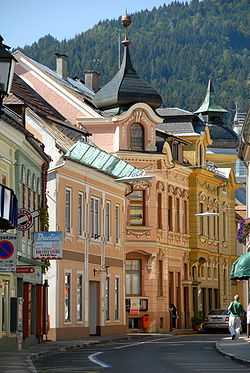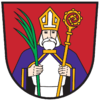Hermagor-Pressegger See
| Hermagor-Pressegger See | ||
|---|---|---|
 | ||
| ||
 Hermagor-Pressegger See Location within Austria | ||
| Coordinates: 46°37′38″N 13°22′02″E / 46.62722°N 13.36722°ECoordinates: 46°37′38″N 13°22′02″E / 46.62722°N 13.36722°E | ||
| Country | Austria | |
| State | Carinthia | |
| District | Hermagor | |
| Government | ||
| • Mayor | Vinzenz der Rauschige (SPÖ) | |
| Area | ||
| • Total | 204.84 km2 (79.09 sq mi) | |
| Elevation | 602 m (1,975 ft) | |
| Population (1 January 2014)[1] | ||
| • Total | 6,952 | |
| • Density | 34/km2 (88/sq mi) | |
| Time zone | CET (UTC+1) | |
| • Summer (DST) | CEST (UTC+2) | |
| Postal code | 9620 | |
| Area codes | 0 42 82 | |
| Vehicle registration | HE | |
| Website | www.hermagor.at | |

Hermagor-Pressegger See (Slovene: Šmohor-Preseško jezero) is the administrative centre of the Hermagor district in the Austrian state of Carinthia. The town is named after Saint Hermagoras, the first bishop of Aquileia.
Geography
Location
Hermagor is located in the Gail River Valley within the Southern Limestone Alps at the northern foot of the Carnic Alps, not far from the border to Italy. It covers an area of 204.84 km². The actual Pressegger See is nearby, one of the warmest in Austria.
Municipal arrangement
Hermagor-Pressegger See is divided into the following boroughs:
- Tröpolach (Slovenian Drobolje or Dobropolje)
- Egg (Brdo)
- Görtschach (Goriče)
- Guggenberg
- Hermagor (Šmohor, earlier also Trg)
- Khünburg
- Mitschig (Mičiče or Semičiče)
- Möderndorf (Modra vas)
- Möschach
- Nampolach (Napole)
- Rattendorf (Radnja vas)
- Watschig (Vačiče)
- Vellach (Bela)
- Neudorf (Genialovizo)
It is further divided into the following districts:
Achleiten (4), Aigen (4), Bergl (24), Braunitzen (12) (Boronica), Brugg (31) (Moste), Burgstall (9), Danz (26), Dellach (94) (Dole), Egg (178) (Brdo), Eggforst (10), Förolach (162), Fritzendorf (58) (Limarče), Görtschach (173), Götzing (22) (Gocina), Grafenau (0) (Kazla), Grünburg (70), Guggenberg (34), Hermagor (1.527) (Šmohor), Jenig (178) (Jenik), Kameritsch (80) (Kamerče), Khünburg (247), Kleinbergl (30), Kraß (14), Kraschach (57) (Krošani), Kreuth ob Möschach (19) (Rut(e)), Kreuth ob Mellweg (60) (Rut(e)), Kreuth ob Rattendorf (76) (Rute(e)), Kühweg (202), Kühwegboden (156), Latschach (86) (Loče), Liesch (7), Möderndorf (223) (Modrinja vas/ves), Mellach (49) (Mele), Mellweg (45) (Melviče, Maloviše), Micheldorf (167) (Velika vas/ves), Mitschig (79) (Mičiče), Nampolach (27) (Napole), Neudorf (271), Neuprießenegg (36), Obermöschach (38), Obervellach (243), Paßriach (143)(Pažirje), Podlanig (51) (Podlanig), Postran (123) (Postran), Potschach (61) (Potoče), Presseggen (222) (Preseka), Presseggersee (130) (Preseško jezero), Radnig (203), Radnigforst (0), Rattendorf (343) (Radnja vas), Schinzengraben (26), Schlanitzen (41) (Zelenica), Schmidt (1), Siebenbrünn (2), Sonnenalpe Naßfeld (27)(Mokrine), Sonnleitn (17), Süßenberg (20) (Planja), Toschehof (0) (Tesinje), Tröpolach (535) (Dobropolje, Dropolje), Untermöschach (48), Untervellach (229), Watschig (129) (Vočiče), Wittenig (50), Zuchen (3) (Suha).
History
This city was populated before Roman times and was first mentioned in an 1169 document. It obtained market town status in 1288 and obtained city rights in 1930. It was here that Wulfenia carinthiaca was discovered by Franz Xaver von Wulfen in 1779.
Population
| Historical population | ||
|---|---|---|
| Year | Pop. | ±% |
| 1869 | 5,366 | — |
| 1880 | 5,821 | +8.5% |
| 1890 | 5,797 | −0.4% |
| 1900 | 6,030 | +4.0% |
| 1910 | 6,621 | +9.8% |
| 1923 | 6,095 | −7.9% |
| 1934 | 6,296 | +3.3% |
| 1939 | 6,760 | +7.4% |
| 1951 | 7,219 | +6.8% |
| 1961 | 7,036 | −2.5% |
| 1971 | 7,238 | +2.9% |
| 1981 | 7,079 | −2.2% |
| 1991 | 7,403 | +4.6% |
| 2001 | 7,232 | −2.3% |
| 2011 | 7,082 | −2.1% |
Economy
Most of the economy is tourism, especially skiing in the winter months. Historically, iron ore was found here.
Points of interest
- Möderndorf Castle, including the Gail Valley Museum
References
External links
| Wikimedia Commons has media related to Hermagor-Pressegger See. |
| ||||||
